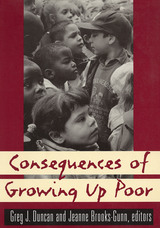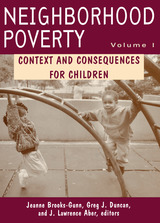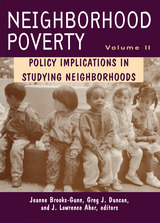3 books by Brooks-Gunn, Jeanne

Consequences of Growing Up Poor
Greg J. Duncan
Russell Sage Foundation, 1997
One in five American children now live in families with incomes below the povertyline, and their prospects are not bright. Low income is statistically linked with a variety of poor outcomes for children, from low birth weight and poor nutrition in infancy to increased chances of academic failure, emotional distress, and unwed childbirth in adolescence. To address these problems it is not enough to know that money makes a difference; we need to understand how. Consequences of Growing Up Poor is an extensive and illuminating examination of the paths through which economic deprivation damages children at all stages of their development. In Consequences of Growing Up Poor, developmental psychologists, economists, and sociologists revisit a large body of studies to answer specific questions about how low income puts children at risk intellectually, emotionally, and physically. Many of their investigations demonstrate that although income clearly creates disadvantages, it does so selectively and in a wide variety of ways. Low-income preschoolers exhibit poorer cognitive and verbal skills because they are generally exposed to fewer toys, books, and other stimulating experiences in the home. Poor parents also tend to rely on home-based child care, where the quality and amount of attention children receive is inferior to that of professional facilities. In later years, conflict between economically stressed parents increases anxiety and weakens self-esteem in their teenaged children. Although they share economic hardships, the home lives of poor children are not homogenous. Consequences of Growing Up Poor investigates whether such family conditions as the marital status, education, and involvement of parents mitigate the ill effects of poverty. Consequences of Growing Up Poor also looks at the importance of timing: Does being poor have a different impact on preschoolers, children, and adolescents? When are children most vulnerable to poverty? Some contributors find that poverty in the prenatal or early childhood years appears to be particularly detrimental to cognitive development and physical health. Others offer evidence that lower income has a stronger negative effect during adolescence than in childhood or adulthood. Based on their findings, the editors and contributors to Consequences of Growing Up Poor recommend more sharply focused child welfare policies targeted to specific eras and conditions of poor children's lives. They also weigh the relative need for income supplements, child care subsidies, and home interventions. Consequences of Growing Up Poor describes the extent and causes of hardships for poor children, defines the interaction between income and family, and offers solutions to improve young lives. JEANNE BROOKS-GUNN is Virginia and Leonard Marx Professor of Child Development at Teachers College, Columbia University. She is also director of the Center for Young Children and Families, and co-directs the Adolescent Study Program at Teachers College.
[more]

Neighborhood Poverty
Context and Consequences for Children
Jeanne Brooks-Gunn
Russell Sage Foundation, 1997
Perhaps the most alarming phenomenon in American cities has been the transformation of many neighborhoods into isolated ghettos where poverty is the norm and violent crime, drug use, out-of-wedlock births, and soaring school dropout rates are rampant. Public concern over these destitute areas has focused on their most vulnerable inhabitants—children and adolescents. How profoundly does neighborhood poverty endanger their well-being and development? Is the influence of neighborhood more powerful than that of the family? Neighborhood Poverty: Context and Consequences for Children approaches these questions with an insightful and wide-ranging investigation into the effect of community poverty on children's physical health, cognitive and verbal abilities, educational attainment, and social adjustment. This two-volume set offers the most current research and analysis from experts in the fields of child development, social psychology, sociology and economics. Drawing from national and city-based sources, Volume I reports the empirical evidence concerning the relationship between children and community. As the essays demonstrate, poverty entails a host of problems that affects the quality of educational, recreational, and child care services. Poor neighborhoods usually share other negative features—particularly racial segregation and a preponderance of single mother families—that may adversely affect children. Yet children are not equally susceptible to the pitfalls of deprived communities. Neighborhood has different effects depending on a child's age, race, and gender, while parenting techniques and a family's degree of community involvement also serve as mitigating factors. Volume II incorporates empirical data on neighborhood poverty into discussions of policy and program development. The contributors point to promising community initiatives and suggest methods to strengthen neighborhood-based service programs for children. Several essays analyze the conceptual and methodological issues surrounding the measurement of neighborhood characteristics. These essays focus on the need to expand scientific insight into urban poverty by drawing on broader pools of ethnographic, epidemiological, and quantitative data. Volume II explores the possibilities for a richer and more well-rounded understanding of neighborhood and poverty issues. To grasp the human cost of poverty, we must clearly understand how living in distressed neighborhoods impairs children's ability to function at every level. Neighborhood Poverty explores the multiple and complex paths between community, family, and childhood development. These two volumes provide and indispensible guide for social policy and demonstrate the power of interdisciplinary social science to probe complex social issues.
[more]

Neighborhood Poverty
Policy Implications in Studying Neighborhoods
Jeanne Brooks-Gunn
Russell Sage Foundation, 1997
Perhaps the most alarming phenomenon in American cities has been the transformation of many neighborhoods into isolated ghettos where poverty is the norm and violent crime, drug use, out-of-wedlock births, and soaring school dropout rates are rampant. Public concern over these destitute areas has focused on their most vulnerable inhabitants—children and adolescents. How profoundly does neighborhood poverty endanger their well-being and development? Is the influence of neighborhood more powerful than that of the family? Neighborhood Poverty approaches these questions with an insightful and wide-ranging investigation into the effect of community poverty on children's physical health, cognitive and verbal abilities, educational attainment, and social adjustment. This two-volume set offers the most current research and analysis from experts in the fields of child development, social psychology, sociology and economics. Drawing from national and city-based sources, Volume I reports the empirical evidence concerning the relationship between children and community. As the essays demonstrate, poverty entails a host of problems that affects the quality of educational, recreational, and child care services.Poor neighborhoods usually share other negative features—particularly racial segregation and a preponderance of single mother families—that may adversely affect children. Yet children are not equally susceptible to the pitfalls of deprived communities. Neighborhood has different effects depending on a child's age, race, and gender, while parenting techniques and a family's degree of community involvement also serve as mitigating factors. Volume II incorporates empirical data on neighborhood poverty into discussions of policy and program development. The contributors point to promising community initiatives and suggest methods to strengthen neighborhood-based service programs for children. Several essays analyze the conceptual and methodological issues surrounding the measurement of neighborhood characteristics. These essays focus on the need to expand scientific insight into urban poverty by drawing on broader pools of ethnographic, epidemiological, and quantitative data. Volume II explores the possibilities for a richer and more well-rounded understanding of neighborhood and poverty issues. To grasp the human cost of poverty, we must clearly understand how living in distressed neighborhoods impairs children's ability to function at every level. Neighborhood Poverty explores the multiple and complex paths between community, family, and childhood development. These two volumes provide and indispensable guide for social policy and demonstrate the power of interdisciplinary social science to probe complex social issues.
[more]
READERS
Browse our collection.
PUBLISHERS
See BiblioVault's publisher services.
STUDENT SERVICES
Files for college accessibility offices.
UChicago Accessibility Resources
home | accessibility | search | about | contact us
BiblioVault ® 2001 - 2024
The University of Chicago Press









